Diary from a space project – Friday, 2 March 2012
Key milestones in launch campaign
17 Jan — Joint Operations Readiness Review — done
1 Feb — Final Acceptance Review — done
3 Feb — Operations Readiness Review — done
16 Feb — Stage Operations Readiness — done
5 Mar — Launch Readiness Review (LRR) — New date to be set
9 Mar — Launch — New date to be set
Today’s update from Charlotte Beskow reports on launch preparations during the past several weeks leading up to yesterday’s discovery that a launch delay would be necessary – read full post for details – Ed. Note: updated 3.03 to correct typos and quotation at end of post.
Murphy never sleeps!
Just when you think all is going well, Murphy will wake up and jumble the cards a bit! Today, 2 March, started with the announcement of a launch delay for Edoardo. Teams are now busy working out the implications and the emails are flying around — there are details at the end of the post.
To begin, here is a short summary of the last few weeks…
7 Feb: ATV was transferred to the BAF (Final Assembly Building in Kourou) using a special container, called the ‘CCU3’. As you can see in the picture, it is a BIG container…
Two days later, ATV-3 was lifted on top of the Ariane 5. This is a great moment for all of us — it signifies that we are really on the final stretch for launch.
At this point in time, we are in the ‘POC’ (Plan des Operations Combineés) phase of the launch campaign at Kourou, where each activity related to ATV is tightly coordinated with activities related to preparing the Ariane launcher. Final preparation of the launcher includes fuelling and final checkout, so basically everyone in Kourou is working on top of a huge fuel reservoir… you can imagine the safety constraints! Coordination is paramount since the various teams work independently on different levels in the BAF and cannot see each other.
10 Feb: Final TM (telemetry) check is done to ensure that the ATV-CC mission control team in Toulouse can see the telemetry sent from ATV using the links that will be up and running during the pre-launch phase (This is basically a cable link from ATV on top of Ariane to the ATV-CC control centre – Ed.).
13 Feb: Vega is launched! Vega is a whole different rocket, a new European development. First launches are always tricky; no matter how much you simulate, you are never certain of the final results — “the proof is in the pudding” as the British say.
 This launch went off without a hitch!! Congratulations to the concerned teams. The only impact it had on ATV work was a 4 hour shift in our work since, for safety reasons, the teams could not access the BAF until after the launch.
This launch went off without a hitch!! Congratulations to the concerned teams. The only impact it had on ATV work was a 4 hour shift in our work since, for safety reasons, the teams could not access the BAF until after the launch.
Feb 13 we also lost our AIV manager, No one is irreplaceable but all the teams were saddened by this premature departure.
In general, projects that run for as long as ours continuously suffer the loss of key people for one reason or another. We have to make sure that we both continuously devote time and resources to train deputies and newcomers, and that we consistently document what we do and why. The latter can be hard to do when you are running as fast as you can. While you are working an issue everything is clear to all concerned and the minutes of a meeting can be both brief and cryptic. Two months later you might not be able to understand the same minutes because that knowledge has been supplanted by new information or by other problems….
Personally I sometimes have a hard time remembering where I was last week… which is one of the main reasons I keep a diary!
14 & 15 Feb (Tuesday & Wednesday): Late cargo integration. This tricky operations involves opening the docking hatch with ATV set in a vertical position on top of the launcher.
Loading is done by hand, bag by bag, by descending into the cargo space using a mechanical elevator (the ‘LCAM’ seen in photo below – Ed.). The elevator does not go all the way down; it only goes low enough to access the uppermost, empty storage shelves inside ATV.
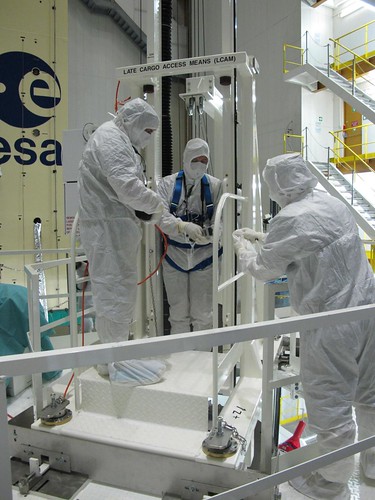 In order to ensure that the loading of the big, so-called ‘M01’ bag, was possible, a mock loading was done at a special facility in Switzerland in January. The trick is not to drop anything (which would then be lost in the interior of ATV), so the technician/operator is carefully checked to ensure the absence of any loose items before descending (pens, glasses, lens cover on the camera and so forth). Murphy never sleeps…!
In order to ensure that the loading of the big, so-called ‘M01’ bag, was possible, a mock loading was done at a special facility in Switzerland in January. The trick is not to drop anything (which would then be lost in the interior of ATV), so the technician/operator is carefully checked to ensure the absence of any loose items before descending (pens, glasses, lens cover on the camera and so forth). Murphy never sleeps…!
581 kg were loaded this way, bringing the total dry cargo to 2,200 kg. (We’ll have an in-depth post next week from ESA’s cargo engineer Kirsten MacDonnell detailing what, exactly, ATV-3 is carrying into orbit – Ed.)
16 Feb, Thursday: Final inspection before closing the hatch! This is done so that we know exactly what state we left the interior in — as of the last moment. This is important in case questions are raised when ATV is in orbit. Photos are taken and analysed and an OK is given before the aerodynamic fairing comes down on top of ATV to ‘encapsulate’ the vessel.
20 Feb, Monday: The teams at ATV-CC teams — the Flight Control Team and the Engineering Support Team (FCT & EST) — conduct a simulation of the nominal ATV Launch and Early Operations phase (LEOP).
Since I spent so much time in Kouoru for this campaign I am a bit rusty; luckily it seems as if the knowledge resides in the ‘muscle memory’ rather than my head because the passwords and the commands to interact with the systems seemed to pop out of nowhere of their own accord. Nevertheless, I was grateful that this was one simulation without the sim conductor deciding to send ATV into survival mode… It gave us a chance to practice our ‘normal’ procedures.
Meanwhile, back in Kourou, the teams (including the AIV team) were busy with final tasks before the fairing goes on. Removal of covers, caps and protectors, for example. In general, items to be removed are brightly marked in red and each removal is carefully tracked.
21 & 22 Feb (Tuesday & Wednesday): The EST team finalise their procedures, check their displays and do the final coordination. Spread over three sites (Les Mureaux in France, ESTEC in NL and Bremen in DE), we have to take every opportunity we can get to talk ‘face-to-face’. Email is a tool but definitely not a replacement for real human contact.
23 Feb, Thursday: The ATV-CC teams (FCT and EST) run the final nominal rendezvous and docking simulation (sim). Murphy is wide awake and manifests his presence by preventing the simulator from correctly starting. No telecommands can be sent and the simulation is delayed by several hours. “Can the EST come back tomorrow?” they ask me at one point. “No,” I reply. The EST leaves tonight… this project is a lot about the sheer logistics involved in getting the right people to the right place at the right time and for the right task 🙂
The technicians figure out the problem, solve it and the sim starts. They find a way of starting a bit into the flight without compromising the objectives and everything runs really smoothly. With just one hour of delay with respect to the planned end-time, the various EST members grab their bags and run out the door in order to still catch their trains / planes. Another milestone on our way to launch!!
25 Feb, Saturday: In Kourou, the OK is given for fairing installation
27 Feb, Monday: Fairing installation.
Delay
1 Mar, Thursday: Our Quality Review Board (QRB) discuss a problem related to the late cargo loading that was identified a couple of days earlier. It’s better to be safe than sorry, and when seen a problem, no matter how late it is identified, it must be addressed.
The available plans of action range from ‘launch as is’, to ‘stop and fix the problem’. It all comes down to a proper risk assessment of the consequences of (a) doing nothing and (b) doing something.
After careful analysis and lengthy discussions, the decision is taken to rectify the problem, even though it means re-opening ATV’s hatch — and this when the vessel has already been encapsulated.
This, in turn, will require removal of the fairing and re-installation of mechanical elevator (the LCAM) to allow an operator to descend into ATV. All of this takes time and — with regret — the ESA Mission Manager, Massimo Cislaghi, is obliged to announce a launch delay.
Even with this delay, at this time, we expect we can meet the ATV docking window that runs to the end of March.
To quote the advertisement campaign that used to be seen in Schiphol airport (the one of a famous golfer standing in a thicket with grass up to his knees and addressing the golf ball): “This is not a setback, it is a challenge.”
Stay tuned…
— Charlotte

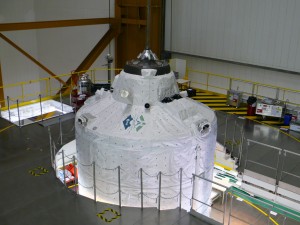
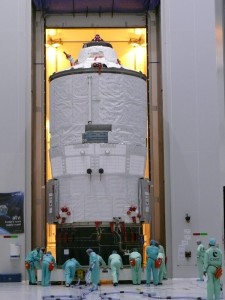
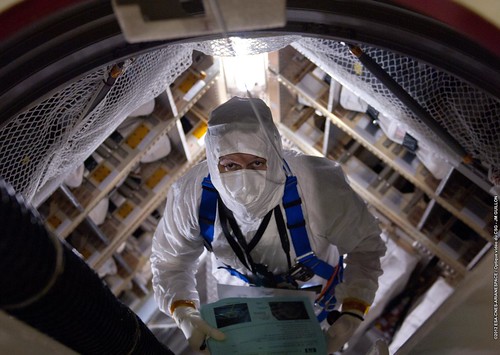
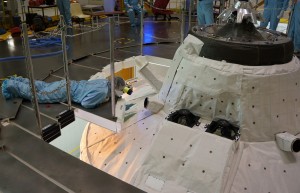
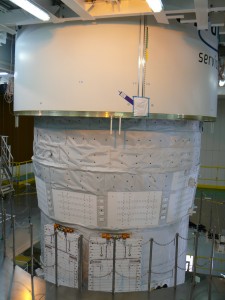
 Automated Transfer Vehicle page
Automated Transfer Vehicle page ATV blog archive
ATV blog archive
Discussion: no comments